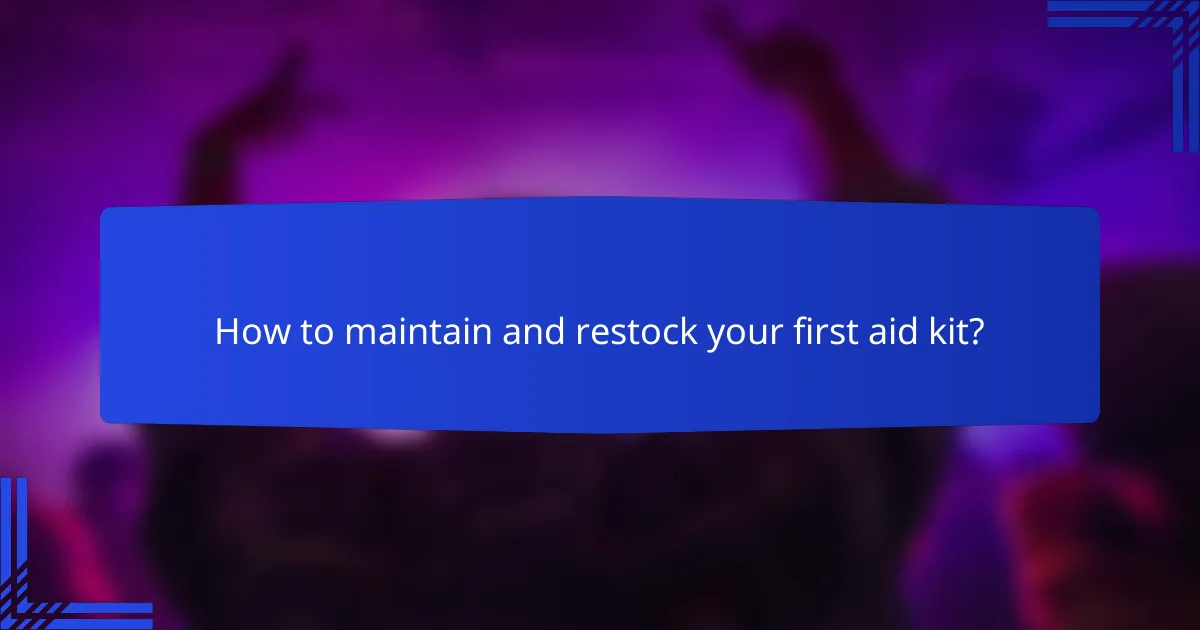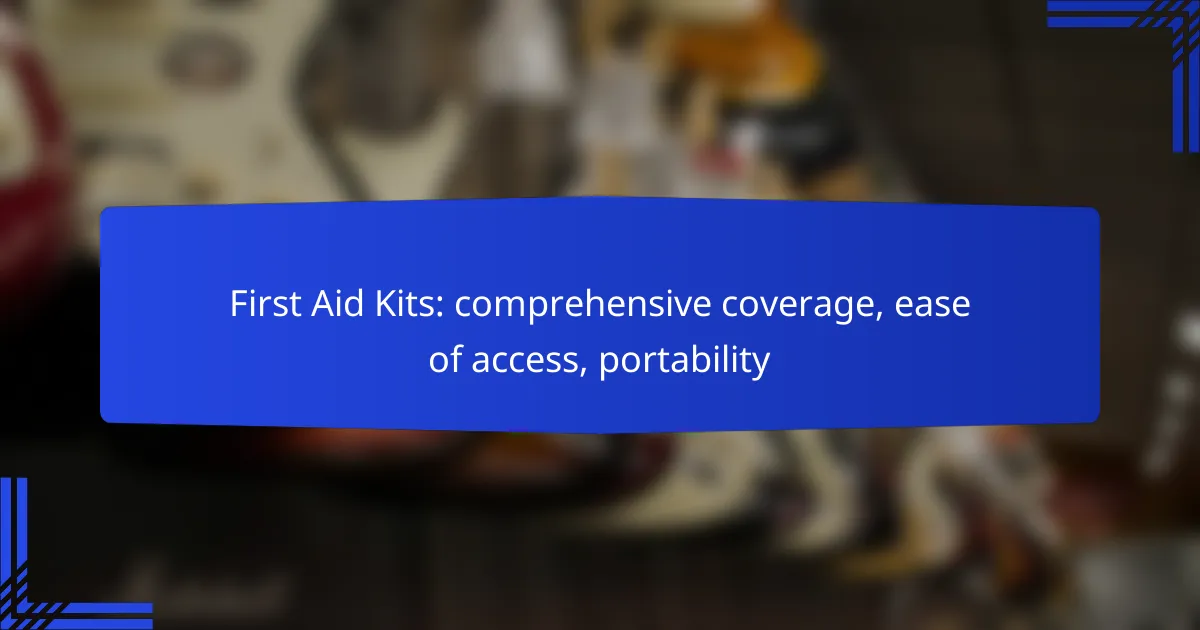First aid kits are essential for managing injuries and emergencies, whether at home or outdoors. The best kits provide comprehensive coverage of necessary supplies, ensuring easy access and portability for various situations. When choosing a kit, consider the specific needs of your environment and the types of injuries you may encounter.

What are the best first aid kits for home use in New Zealand?
The best first aid kits for home use in New Zealand are those that offer comprehensive coverage, easy access to supplies, and portability. When selecting a kit, consider the types of injuries most likely to occur in your household and ensure the kit meets local regulations and standards.
St John First Aid Kit
The St John First Aid Kit is a popular choice among New Zealand households, known for its extensive range of supplies. It typically includes bandages, antiseptics, and other essential items, making it suitable for treating common injuries and emergencies.
When purchasing a St John kit, look for options that fit your specific needs, such as family size or activity level. The kits are designed for easy access, with organized compartments that help you find supplies quickly during emergencies.
Red Cross First Aid Kit
The Red Cross First Aid Kit is another excellent option, emphasizing preparedness and education. This kit often comes with instructional materials, which can be beneficial for those unfamiliar with first aid procedures.
Consider the Red Cross kit if you want a comprehensive guide alongside your supplies. It typically includes items for treating minor injuries, as well as more serious conditions, ensuring you are well-equipped for various situations.
Smart Medical First Aid Kit
The Smart Medical First Aid Kit stands out for its compact design and portability, making it ideal for families on the go. This kit is particularly useful for outdoor activities, as it includes items tailored for common outdoor injuries.
When selecting a Smart Medical kit, check the contents to ensure it includes necessary items like splints and burn dressings. Its lightweight design allows for easy transport, ensuring you can take it along on trips or outings without hassle.

How to choose a first aid kit for outdoor activities in New Zealand?
Selecting a first aid kit for outdoor activities in New Zealand involves considering portability, essential supplies, and waterproof features. A well-chosen kit ensures you are prepared for common injuries and emergencies while enjoying the country’s diverse landscapes.
Consider portability
Portability is crucial for outdoor activities, as you need a first aid kit that is easy to carry. Look for kits that are lightweight and compact, allowing for easy storage in backpacks or vehicles. A good rule of thumb is to choose a kit that weighs no more than a few kilograms.
Additionally, consider the carrying method. Kits with handles or straps can enhance convenience, especially during long hikes or camping trips. Ensure the kit can be securely fastened to your gear to prevent it from getting lost or damaged.
Check for essential supplies
When evaluating a first aid kit, ensure it contains essential supplies for treating common outdoor injuries. Look for items such as adhesive bandages, antiseptic wipes, gauze pads, and adhesive tape. A well-equipped kit may also include a CPR face shield, scissors, and tweezers.
In New Zealand, consider including specific items for local hazards, such as snake bite kits or sting relief for insect bites. Regularly check and replenish supplies to ensure everything is within expiry dates and ready for use.
Evaluate waterproof features
Waterproof features are vital for outdoor first aid kits, especially in New Zealand’s unpredictable weather. A waterproof bag or container will protect your supplies from rain, splashes, or accidental submersion. Look for kits that are rated as waterproof or water-resistant.
Additionally, consider using waterproof pouches for critical items, such as medications or documents. This extra layer of protection can be crucial during wet conditions, ensuring that your first aid supplies remain effective when you need them most.

What are the essential items in a first aid kit?
A first aid kit should contain a variety of essential items to effectively manage minor injuries and emergencies. Key components include adhesive bandages, antiseptic wipes, and gauze pads, among others, to ensure comprehensive coverage and ease of access when needed.
Adhesive bandages
Adhesive bandages, commonly known as Band-Aids, are crucial for protecting small cuts and abrasions. They come in various sizes and shapes to accommodate different injuries, providing a barrier against dirt and bacteria.
When selecting adhesive bandages, consider options with breathable materials and waterproof features for added durability. It’s advisable to have a range of sizes in your kit to suit various wound types.
Regularly check your supply to replace any used or expired bandages, ensuring you are always prepared for minor injuries.
Antiseptic wipes
Antiseptic wipes are vital for cleaning wounds and preventing infection. These wipes typically contain alcohol or other antiseptic agents that effectively kill germs on the skin’s surface.
Keep a sufficient stock of antiseptic wipes in your first aid kit, as they are easy to use and provide immediate sanitation. Look for individually packaged wipes for convenience and to maintain hygiene.
Be mindful of any skin sensitivities; choose wipes that are free from harsh chemicals if needed, especially for children or sensitive skin.
Gauze pads
Gauze pads are essential for dressing larger wounds and controlling bleeding. They are available in various sizes and can be used in conjunction with adhesive tape to secure them in place.
When stocking gauze pads, consider having both sterile and non-sterile options. Sterile pads are ideal for open wounds, while non-sterile can be used for less critical applications.
Always ensure that your gauze pads are properly sealed and stored in a dry place to maintain their sterility until needed. Regularly review your supplies to replace any that have been used or are nearing expiration.

How to maintain and restock your first aid kit?
Maintaining and restocking your first aid kit is essential to ensure it is always ready for emergencies. Regular checks and immediate replacements of used items help keep your kit effective and compliant with safety standards.
Regularly check expiration dates
Expiration dates on medical supplies indicate their effectiveness and safety. Regularly checking these dates, at least every six months, ensures that all items in your first aid kit are reliable when needed.
Consider creating a simple checklist to track expiration dates. Mark items that are nearing expiration and plan to replace them promptly. This proactive approach can prevent potential issues during emergencies.
Replace used items immediately
After using any item from your first aid kit, replace it as soon as possible to maintain readiness. This practice ensures that your kit remains fully stocked and functional for future needs.
Keep a list of essential items that are frequently used, such as bandages, antiseptics, and pain relievers. By monitoring usage and restocking these items immediately, you can avoid being caught unprepared in urgent situations.

What are the benefits of portable first aid kits?
Portable first aid kits offer essential benefits such as comprehensive coverage for a variety of injuries and conditions, ease of access during emergencies, and convenient transport. These kits are designed to be compact and organized, ensuring that individuals can respond quickly and effectively to medical situations.
Easy transport
Portable first aid kits are designed for easy transport, allowing users to carry them in bags, cars, or even on their person. Many kits are lightweight and compact, making them suitable for various activities like hiking, camping, or traveling. When selecting a kit, consider options that fit easily into your daily routine or specific outings.
Look for kits with durable cases that can withstand outdoor conditions and are waterproof or water-resistant. This ensures that the contents remain protected and accessible, regardless of the environment.
Quick access in emergencies
In emergencies, quick access to a first aid kit can be crucial. Portable kits are often designed with organized compartments, allowing users to locate supplies swiftly. Familiarizing yourself with the layout of your kit can save valuable time during a crisis.
To enhance accessibility, consider keeping your first aid kit in a designated spot that is easy to reach, such as in your car’s glove compartment or a specific area in your home. Regularly check the kit to ensure that supplies are stocked and within their expiration dates, ensuring readiness when needed.

What are the regulations for first aid kits in workplaces in New Zealand?
In New Zealand, workplaces are required to have first aid kits that comply with the Health and Safety at Work Act. These regulations ensure that employees have access to necessary medical supplies in case of emergencies.
Compliance with Health and Safety at Work Act
The Health and Safety at Work Act mandates that employers provide a safe working environment, which includes having adequate first aid facilities. This means that first aid kits must be easily accessible and stocked with appropriate supplies based on the specific risks associated with the workplace.
Employers should regularly review and update their first aid provisions to align with any changes in workplace hazards or employee numbers. Training staff in first aid procedures is also a critical component of compliance.
Minimum supply requirements
The minimum supply requirements for first aid kits in New Zealand are outlined in the Approved Code of Practice for First Aid in the Workplace. Kits should contain items such as adhesive bandages, sterile gauze, antiseptic wipes, and scissors, among others.
For low-risk workplaces, a basic kit may suffice, while higher-risk environments may require more comprehensive supplies. Employers should assess their specific needs and ensure that kits are replenished regularly to maintain compliance and readiness for emergencies.
